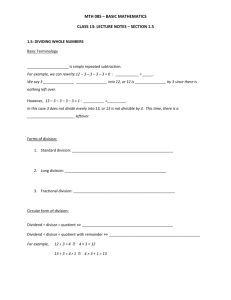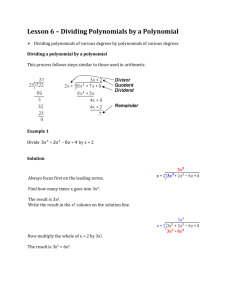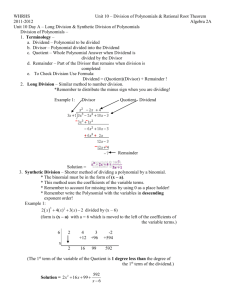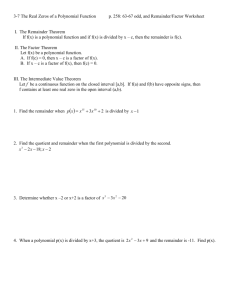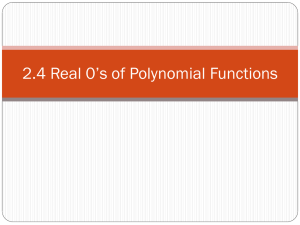4.3.1
advertisement
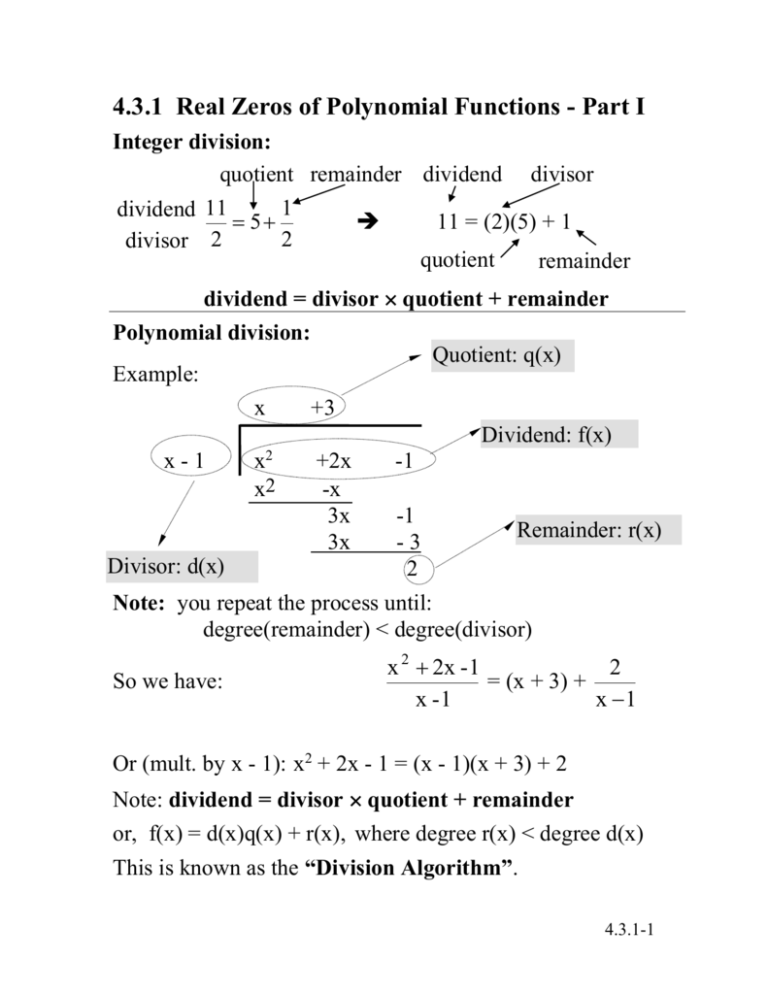
4.3.1 Real Zeros of Polynomial Functions - Part I Integer division: quotient remainder dividend divisor 1 dividend 11 5 11 = (2)(5) + 1 2 divisor 2 quotient remainder dividend = divisor quotient + remainder Polynomial division: Quotient: q(x) Example: x +3 Dividend: f(x) x-1 Divisor: d(x) 2 x x2 +2x -x 3x 3x -1 -1 -3 2 Remainder: r(x) Note: you repeat the process until: degree(remainder) < degree(divisor) So we have: 2 x 2 2x - 1 = (x + 3) + x -1 x 1 Or (mult. by x - 1): x2 + 2x - 1 = (x - 1)(x + 3) + 2 Note: dividend = divisor quotient + remainder or, f(x) = d(x)q(x) + r(x), where degree r(x) < degree d(x) This is known as the “Division Algorithm”. 4.3.1-1 Synthetic division useful for (quick) division by x - a (a is a constant) does not work for other cases x 2 + 2x - 1 Example: here, a = 1 x - 1 Write out a (coefficients of numerator go here): 1 1 2 -1 __________________ 1 (this is "brought down" from above) Scheme is "multiply and add": 1 1 1 2 1 3 coefficients of quotient -1 3 2 remainder degree(quotient) = degree(dividend) – 1 = 1 (this example) so quotient = x + 3, remainder = 2 Result: 2 x 2 + 2x - 1 = (x + 3) + x - 1 x - 1 Notes: can use synthetic div. to divide by x + 1: a = -1 ] if there are terms missing in dividend, have to supply 0: 3x3 - 2x - 1 would be written as: 3 0 -2 -1 4.3.1-2 Remainder and Factor Theorems divide a polynomial f(x) by (x - c), c a constant by the Division Principle we have: f(x) = (x - c)q(x) + d where d is a constant (= 0 if division comes out “even”) So: f(c) = (c - c)q(c) + d = d REMAINDER THEOREM If you divide a polynomial f(x) by (x - c) and obtain remainder d, then: f(c) = d Application: Given f(x) = 3x2 - 15x - 5, find f(8) Way 1: (Brute force) f(8) = (3)(82) - (15)(8) - 5 = Way 2: (Using Remainder Theorem) Just find remainder of division (3x2 - 15x - 5) (x - 8) : 8 3 -15 -5 FACTOR THEOREM 1. if c is a zero of f(x) then (x - c) is a factor of f(x) 2. if (x - c) is a factor of f(x) then c is a zero of f(x) Example: if 5 is zero of a polynomial, then (x -5) is a factor if (x - 5) is a factor of a polynomial, then 5 is a zero 4.3.1-3 Solutions, zeros, and factors think about the polynomial x2 + 2x - 3 it can also be written (x + 3)(x - 1) so (x - 1) is a factor of the polynomial and, clearly, 1 is a zero of the polynomial x2 + 2x - 3 think about the equation x2 + 2x - 3 = 0 solve: (x + 3)(x - 1) = 0 x = 1, -3 one solution of the equation is x = 1 Relationship between zeros, factors, and solutions The following are equivalent: c is a solution of the equation f(x) = 0 c is a zero of the polynomial f x - c is a factor of the polynomial f x – c divides f(x) with no remainder (evenly) Division and factoring if I tell you that one factor of 24 is 6 can you find the other factor? of course - do 246 = 4 !!! so 24 = 6*4 same holds for polynomials! if x + 4 is a factor of x3 - 28x - 48 (we know it is, because -4 is a zero -- try it!) then do (by synthetic division) (x3 - 28x - 48) (x + 4) = x2 - 4x - 12 and so (x3 - 28x - 48) = (x + 4)(x2 - 4x -12) 4.3.1-4 Applications Example 1: Construct a polynomial P(x) whose zeros are 3, -1 and 7. Using Factor Theorem (Part 1), we can write P(x) = (x - 3)(x + 1)(x - 7) Example 2: Given that x = -4 is a solution of f(x) = x3 - 28x - 48 = 0, factor f(x) completely. x = -4 is a solution of the equation, so -4 is a zero of f(x) , so (x - (-4)) = (x + 4) is a factor of f(x). What is the other factor, q(x)? Find it by division, (x3 - 28x - 48) (x + 4): -4 1 0 -28 -48 q(x) = x2 - 4x - 12 so f(x) = (x + 4)(x2 - 4x -12) = (x + 4)(x - 6)(x + 2) Voila! Factored completely! 4.3.1-5

